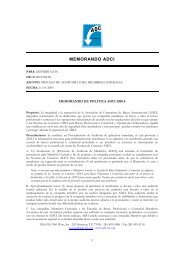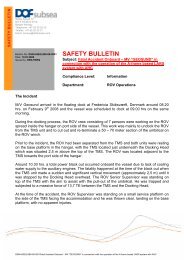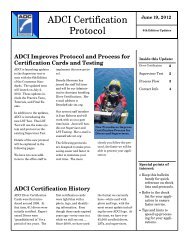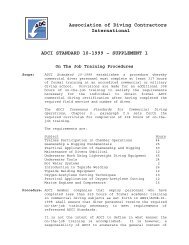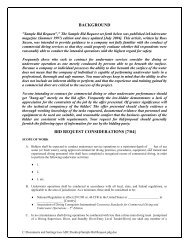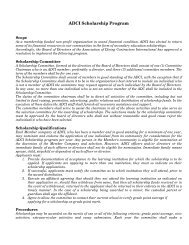DIRECTIVE NUMBER: CPL 02-00-151 EFFECTIVE DATE ... - OSHA
DIRECTIVE NUMBER: CPL 02-00-151 EFFECTIVE DATE ... - OSHA
DIRECTIVE NUMBER: CPL 02-00-151 EFFECTIVE DATE ... - OSHA
You also want an ePaper? Increase the reach of your titles
YUMPU automatically turns print PDFs into web optimized ePapers that Google loves.
y a separate dive-team member; have a standby diver available at the dive<br />
location while the diver is in the water; and have a diver-carried reserve<br />
breathing-gas supply, except when heavy gear is worn.<br />
e. 29 CFR 1910.425(c)(4)(iv). A reserve breathing-gas supply is required at<br />
the dive location for dives deeper than 1<strong>00</strong> fsw or outside the nodecompression<br />
limits.<br />
NOTE: The reserve breathing-gas supply required at the dive location must<br />
be on-line and ready for use, and its source must be independent of the<br />
primary breathing-gas supply. The reserve breathing-gas supply must be of<br />
sufficient quantity and pressure to allow each diver to complete any planned<br />
decompression schedule.<br />
f. 29 CFR 1910.425(c)(5)(i) and (c)(5)(ii). For surface-supplied air diving<br />
with heavy gear, deeper than 1<strong>00</strong> fsw, or outside the no-decompression<br />
limits, an extra breathing-gas hose must be available to the standby diver,<br />
and the hose must be capable of supplying breathing gas to the diver in an<br />
emergency. Also, an inwater stage must be provided for the diver(s) in the<br />
water.<br />
g. 29 CFR 1910.425(c)(6). A diver-carried reserve breathing-gas supply must<br />
be provided to a diver in the water when the diver is prevented by the<br />
configuration of the dive area from ascending directly to the surface (i.e.,<br />
when the diver does not have “free access to the surface”), except when the<br />
diver wears heavy gear or when the physical space does not permit the use<br />
of such a breathing-gas supply. The diver-carried reserve must be sufficient<br />
under operating conditions to allow the diver to reach the surface, or another<br />
source of breathing gas, or to be reached by a standby diver. Heavy-gear<br />
diving is exempted from these provisions because the gear carries its own<br />
reserve.<br />
NOTE: For vessels without longitudinal (horizontal) stabilizers, “free<br />
access to the surface” means that the diver is diving above the turn of the<br />
bilge; for vessels with longitudinal stabilizers (usually found on military<br />
combat vessels), “free access to the surface” means that the diver is diving<br />
above the stabilizers.<br />
3. Commercial surface-supplied air diving with one diver in the water requires a<br />
minimum of three dive-team members: a DPIC (see 29 CFR 1910.410(c)), and<br />
a diver “who shall be continuously tended [by a tender other than the DPIC]<br />
while in the water” (see 29 CFR 1910.425(c)(1)). For surface-supplied air<br />
diving that is 1<strong>00</strong> feet or less and does not involve planned decompression, a<br />
standby diver is not a specified requirement for every dive. However, based on<br />
the requirements of 29 CFR 1910.421(d) Planning and assessment, the hazard<br />
analysis and assessment of the dive will dictate the use of a standby diver when<br />
underwater conditions and hazards or potential hazards involve: proximity to<br />
underwater differential pressure flow (e.g., pump intake suction, gravity drain,<br />
31


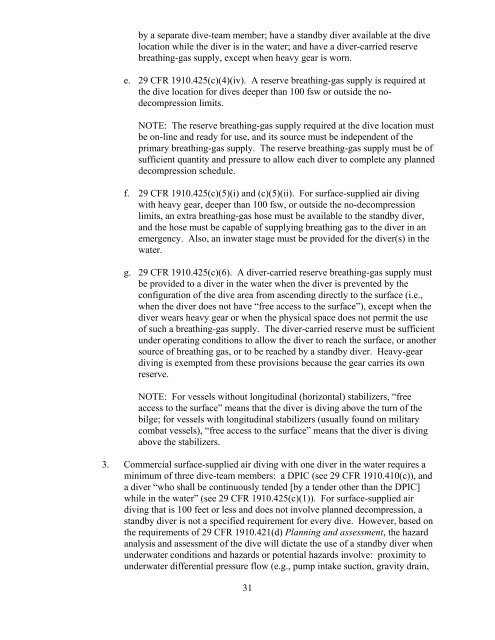
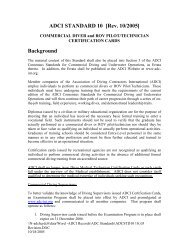
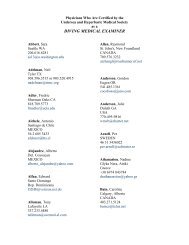
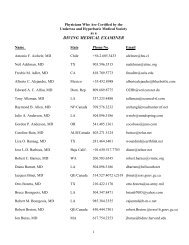
![SOLICITUD MEMBRESIA ASOCIADO [Rev 06/08] - Association of ...](https://img.yumpu.com/48291988/1/190x245/solicitud-membresia-asociado-rev-06-08-association-of-.jpg?quality=85)

